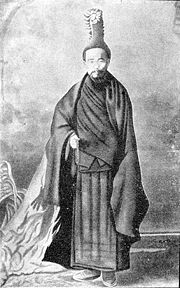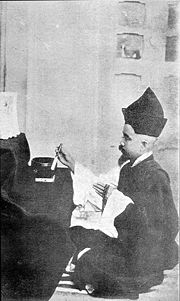
Ekai Kawaguchi
Encyclopedia




Japanese people
The are an ethnic group originating in the Japanese archipelago and are the predominant ethnic group of Japan. Worldwide, approximately 130 million people are of Japanese descent; of these, approximately 127 million are residents of Japan. People of Japanese ancestry who live in other countries...
Buddhist monk, famed for his four journeys to Nepal
Nepal
Nepal , officially the Federal Democratic Republic of Nepal, is a landlocked sovereign state located in South Asia. It is located in the Himalayas and bordered to the north by the People's Republic of China, and to the south, east, and west by the Republic of India...
(in 1899, 1903, 1905 and 1913), and two to Tibet
Tibet
Tibet is a plateau region in Asia, north-east of the Himalayas. It is the traditional homeland of the Tibetan people as well as some other ethnic groups such as Monpas, Qiang, and Lhobas, and is now also inhabited by considerable numbers of Han and Hui people...
(July 4, 1900–June 15, 1902, 1913–1915), being the first recorded Japanese citizen to travel in either country.
Until March, 1891, he had been the Rector
Rector
The word rector has a number of different meanings; it is widely used to refer to an academic, religious or political administrator...
of the Zen
Zen
Zen is a school of Mahāyāna Buddhism founded by the Buddhist monk Bodhidharma. The word Zen is from the Japanese pronunciation of the Chinese word Chán , which in turn is derived from the Sanskrit word dhyāna, which can be approximately translated as "meditation" or "meditative state."Zen...
in Tokyo (which contains 500 rakans - Buddhist images modeled after Buddha's disciples). He then spent about 3 years as a hermit in Kyoto
Kyoto
is a city in the central part of the island of Honshū, Japan. It has a population close to 1.5 million. Formerly the imperial capital of Japan, it is now the capital of Kyoto Prefecture, as well as a major part of the Osaka-Kobe-Kyoto metropolitan area.-History:...
studying Chinese Buddhist texts. He decided to study Tibetan and to travel to Tibet.
He left Japan for Tibet in June, 1897, and returned in May, 1903. According to Sarat Chandra Das
Sarat Chandra Das
Sarat Chandra Das was an Indian scholar of Tibetan language and culture most noted for his two journeys to Tibet in 1879 and in 1881 - 1882-Biography:...
he studied Tibetan and English "for several years" dressed as a Japanese priest at the Darjeeling High School before heading to Tibet. He reached Lhasa in the spring of 1901.
Then he left Japan again in October, 1904 for India and Nepal to study Sanskrit
Sanskrit
Sanskrit , is a historical Indo-Aryan language and the primary liturgical language of Hinduism, Jainism and Buddhism.Buddhism: besides Pali, see Buddhist Hybrid Sanskrit Today, it is listed as one of the 22 scheduled languages of India and is an official language of the state of Uttarakhand...
and search for more manuscripts.
Reverend Kawaguchi took almost four years to reach Lhasa after stopovers at a number of monasteries and a pilgrimage round sacred Mount Kailash
Mount Kailash
Mount Kailash is a peak in the Gangdisê Mountains, which are part of the Himalayas in Tibet...
in western Tibet. He posed as a Chinese monk and gained a reputation as an excellent doctor which led to him having an audience with the 13th Dalai Lama
Dalai Lama
The Dalai Lama is a high lama in the Gelug or "Yellow Hat" branch of Tibetan Buddhism. The name is a combination of the Mongolian word далай meaning "Ocean" and the Tibetan word bla-ma meaning "teacher"...
, Thubten Gyatso (1876 to 1933). He spent some time living in Sera Monastery
Sera Monastery
Sera Monastery is one of the 'great three' Gelukpa university monasteries of Tibet, located north of Lhasa. The other two are Ganden Monastery and Drepung Monastery. The origin of the name 'Sera' is attributed to a fact that the site where the monastery was built was surrounded by wild roses in...
.
While Kawaguchi was in Lhasa, 34 year old Narita Yasuteru, who was a spy for the Japanese Intelligence, visited the city for about a fortnight. Little else is known about this man or what information he took back to Japan.
Kawaguchi seems to have been quite shocked by the lack of hygiene amongst Tibetans, the filth of Tibetan cities, and by many Tibetan customs, including sexual "immorality", lax practices by many of the monks, corruption and superstitious beliefs. On the other hand, he had great admiration for many Tibetans ranging from great religious and political leaders to common people and made many friends while he was in Tibet.
- "At the turn of the [20th] century, reaching Lhasa Tibet, like reaching the moon in our own day, was such a supreme goal and success so rare an accomplishment that in Japan, as elsewhere, competition and controversy naturally arose regarding the Tibetan journeys of various men. Of the half-dozen Japanese who struck out for Lhasa by 1900, only two met with early success. Ekai Kawaguchi arrived in the spring of 1901, and Narita Yasuteru arrived a few months later. Hiroshi (Kan) Naomi died an unsuccessful attempt [at the hand of tribal people on the borderlands between YunnanYunnanYunnan is a province of the People's Republic of China, located in the far southwest of the country spanning approximately and with a population of 45.7 million . The capital of the province is Kunming. The province borders Burma, Laos, and Vietnam.Yunnan is situated in a mountainous area, with...
and Tibet], and Enga Teremoto did not achieve the goal until later in 1904.
- Few places in the world have fired the imagination of adventurers like Tibet, and Japanese especially have had more incentive than most other people to reach Lhasa. There was, for example, their interest in promoting pan-Buddhism, pan-Asianism, and a Buddhist renaissance. Then, there was Japan's desire to counter Western imperialism and block Russian expansion. Less than a dozen Japanese reached Tibet during the first half of this [20th] century, and there has been a great deal of debate and competition among Japanese Tibetologists, their disciples and friends as to the accomplishments and comparative value of the Tibetan activities and studies of these pioneers."
Aside from their perceived lack of hygiene, Kawaguchi also found it difficult to accept the relative equality of Tibetan women:
- "Kawaguchi, a Japanese monk who spent three years in Lhasa in the early twentieth century, was particularly impressed with what he observed: 'The condition of Tibetan women with regard to men, especially in the provinces, may be regarded to surpass the ideal of Western women, so far as the theory of equality of rights between the sexes is concerned.' The rights that Kawaguchi noted included: that to a share of her father's property, which she could keep if she left her marriage; compensation from her husband for the work she did for him; and the right to marry again without stigma. Such things were unthinkable in the China or Japan of a hundred years ago, or even today; no wonder Kawaguchi was so struck by them. At the same time, as a Japanese, he thought that Tibetan women's freedom made them 'loose'. 'They lack weight and dignity, such as command respect from others,' he wrote patronisingly. They 'are prone to flirt and to be flippant ... one [might] say they are more like ballet-girls than ladies of high station.'"
While Kawaguchi was often accused of being a spy, and possibly passing on information (some of it perhaps false) to his friend Sarat Chandra Das
Sarat Chandra Das
Sarat Chandra Das was an Indian scholar of Tibetan language and culture most noted for his two journeys to Tibet in 1879 and in 1881 - 1882-Biography:...
, who was working for the British, there is no information to back this claim.
He was a friend of Mrs. Annie Besant
Annie Besant
Annie Besant was a prominent British Theosophist, women's rights activist, writer and orator and supporter of Irish and Indian self rule.She was married at 19 to Frank Besant but separated from him over religious differences. She then became a prominent speaker for the National Secular Society ...
, President of the Theosophical Society
Theosophical Society
The Theosophical Society is an organization formed in 1875 to advance the spiritual principles and search for Truth known as Theosophy. The original organization, after splits and realignments has several successors...
, who encouraged him to publish the English text of his book, Three Years in Tibet.
Kawaguchi spent most of his time in Tibet in disguise and had to flee the country hurriedly. Several of the people who had sheltered him were horribly tortured and mutilated. In 1903 he approached the Nepalese Prime Minister Chandra Shumsher Rana
Chandra Shamsher Jang Bahadur Rana
Field-Marshal Maharaja Sri Teen Chandra Shamsher Jang Bahadur Rana, , was the fifth Prime Minister of Nepal from the Rana dynasty. He served in this capacity from 27 June 1901, following the deposition of his brother Deva Shamsher Jang Bahadur Rana, to his death in 1929...
for help and, on his recommendation, the Tibetan Government released Kawaguchi's loyal Tibetan friends from jail.
Partly as a result of hearing about the discovery of an Ashoka Pillar in 1896 identifying Lumbini
Lumbini
Lumbinī is a Buddhist pilgrimage site in the Rupandehi district of Nepal. It is the place where Queen Mayadevi gave birth to Siddhartha Gautama, who as the Buddha Gautama founded the Buddhist tradition. The Buddha lived between roughly 563 and 483 BCE...
as the birthplace of Gautama Buddha, he visited Lumbini with other Japanese pilgrims in 1912.
The Government of Nepal issued a postage stamp in 2003 commemorating Kawaguchi's visits to that country. He is also said to have planted two saplings of Himalayan Cicada trees (also called: Riang Riang; Ploiarium alternifolium), which he had brought back with him, near the gate of the Obaku-san Manpukuji Zen
Zen
Zen is a school of Mahāyāna Buddhism founded by the Buddhist monk Bodhidharma. The word Zen is from the Japanese pronunciation of the Chinese word Chán , which in turn is derived from the Sanskrit word dhyāna, which can be approximately translated as "meditation" or "meditative state."Zen...
Buddhist temple on the outskirts of Kyoto
Kyoto
is a city in the central part of the island of Honshū, Japan. It has a population close to 1.5 million. Formerly the imperial capital of Japan, it is now the capital of Kyoto Prefecture, as well as a major part of the Osaka-Kobe-Kyoto metropolitan area.-History:...
, where he had studied as a young man.

